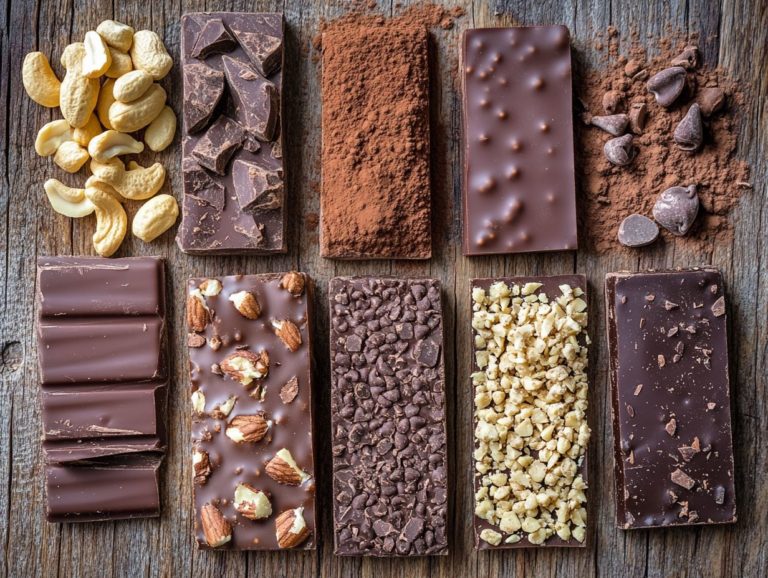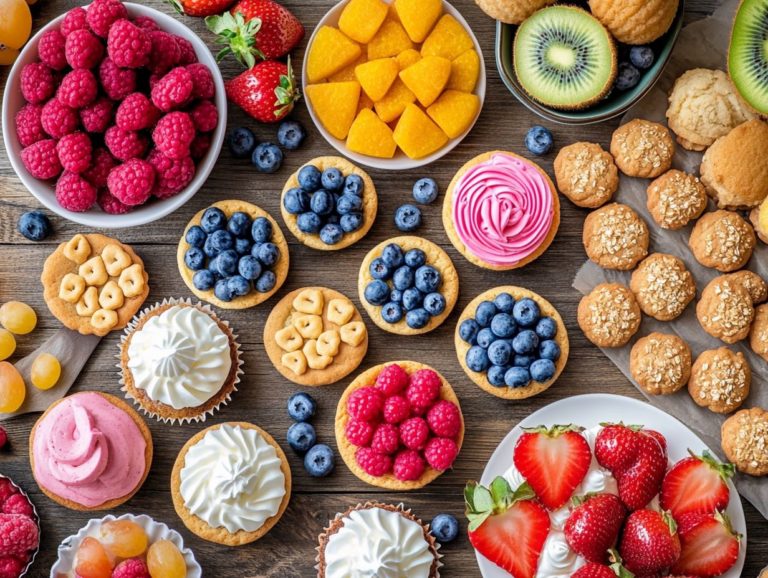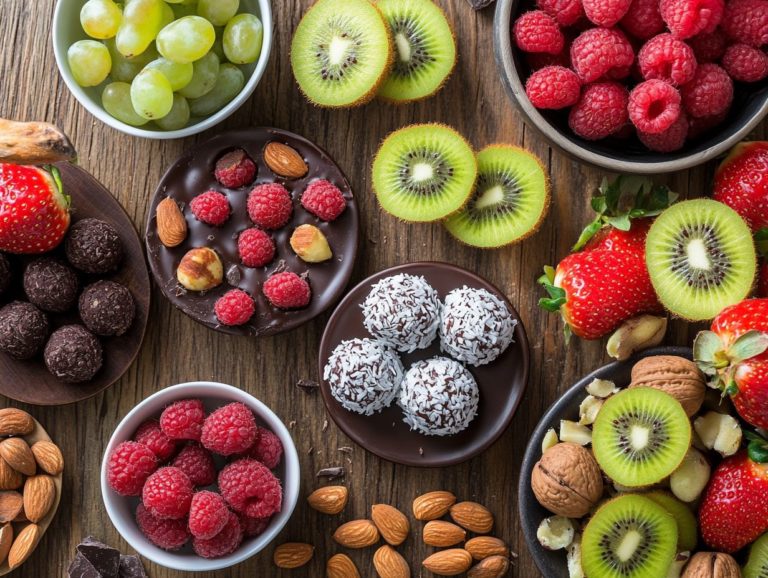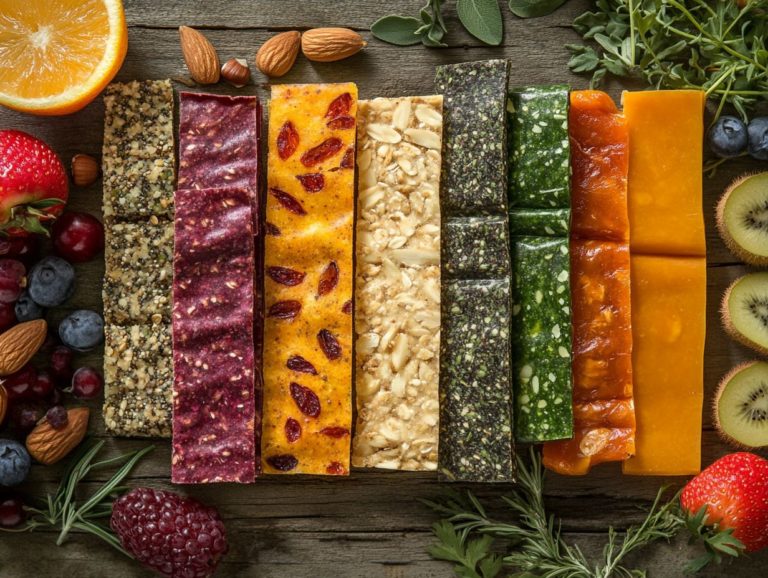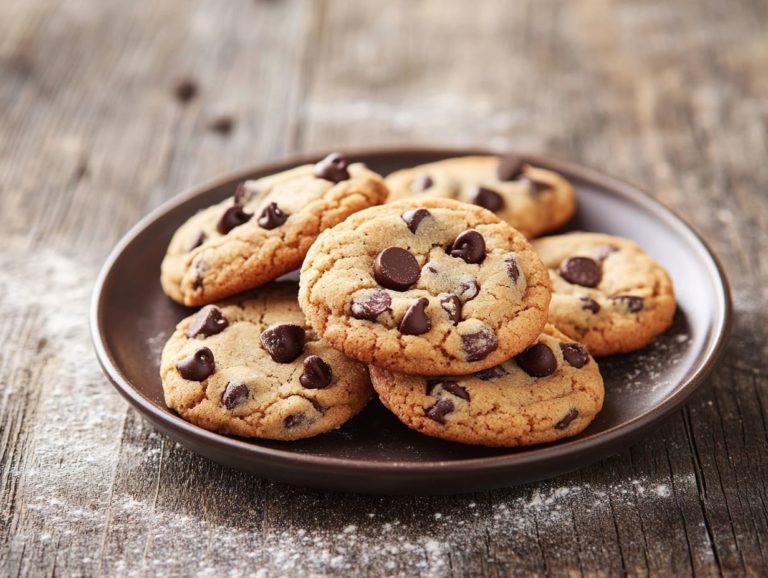Exploring Gluten-Free Baking Substitutes
Gluten-free baking presents an enticing array of delicious possibilities for anyone steering clear of gluten, whether due to celiac disease, gluten sensitivity, or simply personal preference. With the right baking tools and techniques, you can master the art of gluten-free baking.
This guide delves into the essentials of gluten-free baking. You’ll cover everything from the benefits to selecting the finest ingredients and substitutes.
Explore a variety of gluten-free flours, binders, and sweeteners designed to elevate your baked creations. Uncover insightful baking tips and tricks to enhance flavor and moisture, ensuring every bite is a true delight!
Contents
- Key Takeaways:
- What is Gluten-Free Baking?
- Why Choose Gluten-Free Baking?
- What Are the Common Ingredients in Gluten-Free Baking?
- What Are the Best Gluten-Free Binders?
- What Are the Best Gluten-Free Sweeteners?
- How to Make Gluten-Free Baked Goods Taste Better?
- What Are the Best Flavor Enhancers for Gluten-Free Baking?
- How to Add Moisture to Gluten-Free Baked Goods?
- What Are Some Tips for Successful Gluten-Free Baking?
- Frequently Asked Questions
- What are some common gluten-free baking substitutes?
- Can I use regular wheat flour in place of gluten-free flour?
- Are there any natural gluten-free baking substitutes?
- Can I use applesauce as a gluten-free baking substitute?
- What is the best gluten-free flour blend for baking?
- Are gluten-free baking substitutes more expensive than regular baking ingredients?
Key Takeaways:
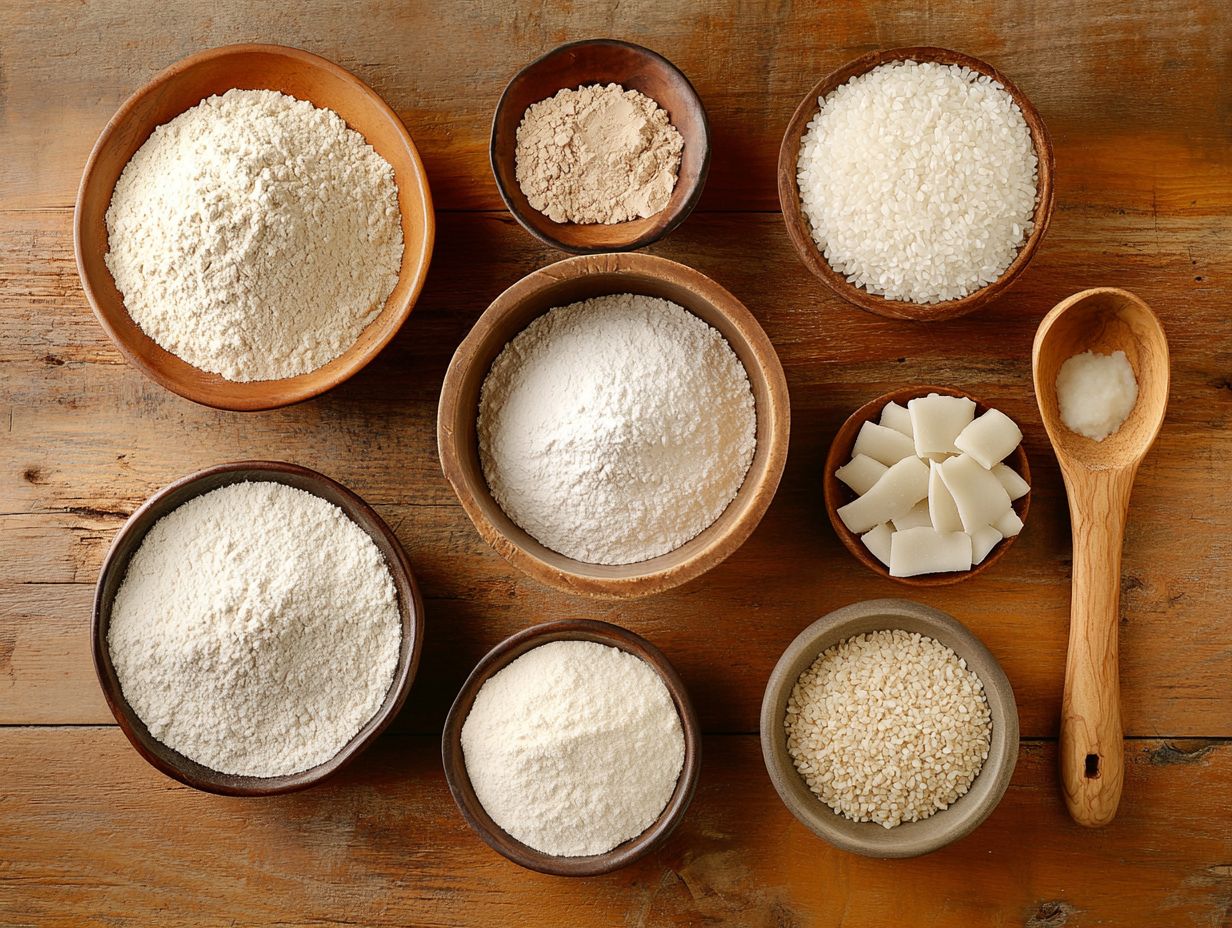
- Gluten-free baking eliminates gluten, a protein found in wheat, barley, and rye.
- Choosing a gluten-free diet can improve digestion, increase energy, and reduce inflammation.
- For best results in gluten-free baking, consider ingredients like almond flour, coconut flour, or a combination of gluten-free flours.
What is Gluten-Free Baking?
Gluten-free baking is a refined approach to cooking designed for those with gluten sensitivity or intolerance, including individuals with celiac disease. This technique uses alternative flours and ingredients that help hold baked goods together, such as xanthan gum, guar gum, and psyllium husk, instead of traditional wheat flour.
Embracing gluten-free baking invites you to experiment with unique textures and flavors, crafting exquisite outcomes for the gluten-free community.
Why Choose Gluten-Free Baking?
Opting for gluten-free baking can profoundly change your life, especially with gluten sensitivity or a gluten-free diet. This choice introduces delightful options and significant nutritional advantages.
By avoiding gluten, you can alleviate uncomfortable symptoms tied to gluten intolerance. You will also discover a diverse array of alternative flours and innovative baking techniques that elevate flavor and texture. There are many vegan substitutes available to cater to various dietary preferences!
What Are the Benefits of a Gluten-Free Diet?
The benefits of a gluten-free diet extend beyond alleviating symptoms. You may enjoy improved digestion, increased energy, and enhanced overall health.
Many individuals experience better nutrient absorption and reduced inflammation while savoring a delightful range of gluten-free treats. Experimenting with various alternative flours can transform traditional recipes into gluten-free masterpieces!
Research shows that incorporating gluten-free grains like quinoa and buckwheat can significantly reduce chronic inflammation. These grains are rich in essential nutrients like protein and fiber.
A gluten-free diet is linked to improvements in mental clarity and reduced fatigue. As more people embrace gluten-free choices, the positive effects on physical and mental well-being are widely recognized!
What Are the Common Ingredients in Gluten-Free Baking?
In gluten-free baking, you’ll need to embrace a unique array of ingredients that take the place of traditional wheat-based components. This enables you to create delicious gluten-free baked goods and desserts with ease.
Common gluten-free flours like almond flour, coconut flour, buckwheat flour, brown rice flour, and sorghum flour offer distinct textures and flavors while keeping your creations light and airy.
By combining these alternative flours with specific baking techniques and binding agents like xanthan gum (a thickener) or guar gum (a stabilizer), you can achieve the perfect consistency and rise in your gluten-free dough, accommodating a variety of dietary preferences.
What Are the Best Gluten-Free Flour Substitutes?
When you venture into gluten-free baking, choosing the right flour substitutes is crucial for attaining the perfect texture and flavor. Consider popular gluten-free options like almond flour, coconut flour, buckwheat flour, brown rice flour, and sorghum flour. Each has unique characteristics and nutritional benefits that can elevate your baking experience.
Understanding the distinct properties of these flours allows you to craft gluten-free recipes that align with dietary preferences while excelling in taste and performance. These choices can transform your traditional recipes into gluten-free masterpieces.
Take almond flour, for example. Its richness in protein and healthy fats makes it an outstanding choice for creating moist and dense treats like cakes and muffins. Coconut flour, on the other hand, absorbs moisture well, so it s best paired with other flours to avoid dryness.
Buckwheat flour lends a delightful nutty flavor, making it particularly ideal for pancakes and breads. Meanwhile, brown rice flour brings a subtle sweetness, proving versatile for various recipes. Sorghum flour offers a distinctive flavor and works well when blended with other gluten-free flours, contributing to a more structured bake.
You can enhance both the texture and nutritional profile of your baked goods by creatively combining these flours, catering to diverse dietary needs and restrictions.
How to Make Your Own Gluten-Free Flour Blend?
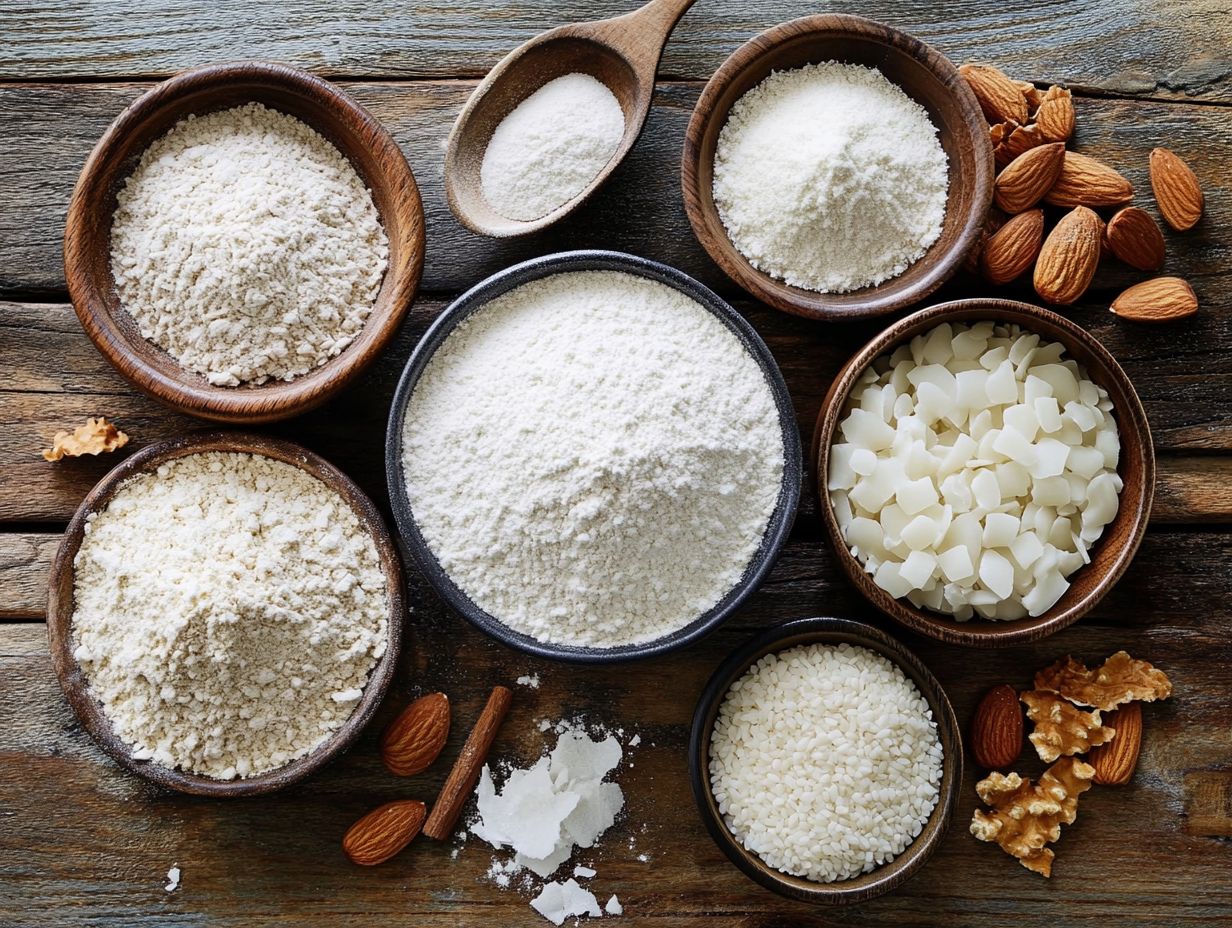
Make your own gluten-free flour blend to customize your baking like a pro! A successful blend might include a harmonious mix of almond flour, brown rice flour, and sorghum flour, striking the perfect balance between moisture retention and structural integrity.
Experimenting with different ratios and incorporating binding agents like xanthan gum or psyllium husk (a thickening and binding agent) helps you refine your gluten-free flour blends to meet your baking needs and preferences, paving the way for success.
To begin, select a base flour that provides a solid foundation, such as brown rice flour, known for its excellent texture and lightness. Then, add a nut flour like almond, which contributes richness and moisture while enhancing overall flavor.
Don t overlook starchy flours, such as tapioca or potato flour; these are essential for achieving the desired lightness and softness in your final product. Integrating binding agents is crucial for mimicking gluten’s elasticity, giving your blend the necessary structure.
Managing moisture is equally important; blending flours with different absorbency rates can help regulate hydration. This ensures your baked goods rise beautifully and boast a delightful texture. Using chia seeds and flaxseed meal can also aid in moisture retention and provide additional nutritional benefits.
What Are the Best Gluten-Free Binders?
Gluten-free binders are essential for achieving the ideal consistency and structure in your baked goods. They compensate for gluten’s natural elasticity and strength. You ll often find xanthan gum, guar gum, and psyllium husk among the most effective binders, each offering unique advantages.
Thoughtfully incorporating these binding agents into your recipes can elevate your baked treats to an artisanal quality, all while catering to the specific needs of those with gluten sensitivities.
What Are the Benefits of Using Xanthan Gum in Baking?
Xanthan gum is an important tool in gluten-free baking, a highly valued binding agent that brings a multitude of benefits for both home bakers and professionals alike. It skillfully mimics the properties of gluten, enhancing the texture and rise of your gluten-free creations, which means a far more enjoyable eating experience.
By incorporating xanthan gum into your gluten-free recipes, you can achieve a consistent texture in dough and batter. This ensures your treats hold their own against those made with traditional wheat flour.
This remarkable ingredient is essential for preventing the crumbly texture often associated with gluten-free products. It provides the cohesiveness needed to maintain shape and structure.
When you use xanthan gum, be mindful of your measurements; typically, one teaspoon per cup of gluten-free flour is the way to go for most recipes.
For best results, mix it thoroughly with your dry ingredients before introducing any wet components, ensuring even distribution throughout.
Whether you re whipping up cookies, bread, or cakes, xanthan gum can elevate your baking to new heights, delivering moist, fluffy, and utterly satisfying baked goods that everyone can enjoy, regardless of dietary restrictions.
Other Gluten-Free Binders
In addition to xanthan gum, you ll find that other gluten-free binders, such as guar gum and psyllium husk, play crucial roles in crafting delightful gluten-free baked goods. Guar gum is renowned for its thickening properties and its ability to enhance moisture retention.
Psyllium husk boosts dough elasticity, making it an excellent choice for gluten-free bread. By familiarizing yourself with the various gluten-free binders available, you can experiment with different combinations to achieve the ideal texture and flavor in your gluten-free recipes.
For example, blending flaxseed meal and chia seeds can create a wonderful gel-like consistency that adds both nutrition and moisture to muffins and pancakes. Arrowroot powder serves as a fantastic alternative for thickening sauces and gravies, ensuring a smooth, glossy finish.
In recipes like gluten-free chocolate chip cookies, incorporating a mixture of these binders can yield a chewy texture that rivals traditional versions. By exploring these options, you open the door to greater creativity in the kitchen, leading to impressive gluten-free dishes that everyone will enjoy.
What Are the Best Gluten-Free Sweeteners?
Selecting the right sweeteners is essential in gluten-free baking, as they can significantly enhance the flavor of your gluten-free treats while aligning with dietary preferences. Opting for natural sweeteners like honey, maple syrup, and agave nectar not only brings sweetness to your creations but also helps retain moisture and improve the overall texture of your baked goods.
By mastering the art of incorporating these gluten-free sweeteners into your recipes, you can elevate your gluten-free desserts, ensuring they are not only delicious but also deeply satisfying.
How to Use Honey as a Sweetener in Gluten-Free Baking?
Using honey as a sweetener in your gluten-free baking not only elevates the flavor of your creations but also adds essential moisture and a distinctive texture, making it an outstanding choice for a variety of gluten-free recipes.
This natural sweetener offers a depth of flavor that sugar alone often struggles to match, thanks to its unique floral notes and rich undertones. Can you imagine the unique floral notes and rich undertones? When you incorporate honey into your recipes, it s crucial to keep the balance of flavors in mind, as honey can be more potent than granulated sugars.
Reducing the quantity slightly and adjusting the other ingredients accordingly will ensure your final product achieves just the right level of sweetness. Honey s natural humectant properties (properties that help retain moisture) help preserve freshness, enhancing the shelf life of your baked goods and boosting their overall appeal.
To truly maximize its benefits, don t hesitate to experiment with different types of honey; each variety brings its own unique characteristics that can transform your dish.
Try incorporating these binders and sweeteners in your next gluten-free baking adventure!
What Are Other Natural Sweeteners for Gluten-Free Baking?

Plus honey, you have a delightful array of natural sweeteners at your disposal for gluten-free baking, each capable of enhancing flavor and maintaining a satisfying texture in your delectable creations.
Sweeteners like maple syrup, coconut sugar, and agave nectar provide unique flavor profiles and varying levels of sweetness, allowing you to tailor your recipes to your personal taste. By understanding the distinct characteristics of these natural sweeteners, you can craft delicious gluten-free desserts that cater to a wide range of dietary needs and preferences.
For example, think about how maple syrup introduces a delightful caramel-like flavor with a warm, earthy sweetness that elevates pancakes and muffins to new heights. Coconut sugar, with its rich, toffee-like taste, is perfect for cookies and bars, while agave nectar’s mild sweetness dissolves effortlessly into batters, making it an ideal choice for cakes and quick breads.
Each of these sweeteners not only adds a touch of sweetness but also brings essential moisture to gluten-free recipes, a key factor in achieving the perfect consistency. Picture yourself whipping up a gluten-free maple walnut loaf or agave-sweetened chocolate chip cookies that everyone will absolutely love!
How to Make Gluten-Free Baked Goods Taste Better?
Enhancing the flavor of your gluten-free baked goods is crucial for achieving the same level of deliciousness as their gluten-containing counterparts. By incorporating flavor enhancers like vanilla extract, citrus zest, or a pinch of spices, you can elevate the taste profile of your gluten-free recipes to new heights.
Moreover, mastering specific baking techniques such as the art of proper mixing and folding can significantly influence the texture and taste of your final creations, ensuring that your gluten-free treats are nothing short of satisfying.
What Are the Best Flavor Enhancers for Gluten-Free Baking?
Flavor enhancers are essential in gluten-free baking, bringing depth and complexity to your baked goods that traditional recipes often boast. Think of ingredients like vanilla extract, almond extract, and various spices; these can elevate a basic gluten-free recipe into something truly delightful. By thoughtfully selecting and mixing these ingredients, you can craft gluten-free desserts that are not only rich in flavor but also satisfying to the palate.
To further enhance the taste experience, consider incorporating citrus zests, such as lemon or orange. These bright flavors can add a refreshing twist to your creations. Nutmeg and cinnamon offer not just warmth and comfort, but they also pair beautifully with gluten-free flour blends, making your treats even more inviting.
If you’re aiming for a hint of sweetness without resorting to sugar, natural sweeteners like maple syrup or honey can double as flavor enhancers while keeping your baked goods moist. For example, imagine gluten-free chocolate chip cookies enriched with almond extract, creating a more nuanced flavor profile. Or picture a gluten-free carrot cake enhanced with cinnamon and nutmeg, filling your kitchen with a warm, homey aroma that beckons everyone to indulge.
How to Add Moisture to Gluten-Free Baked Goods?
Adding moisture to your gluten-free baked goods is crucial for achieving that tender, enjoyable texture. Gluten-free flours tend to be a bit dense.
Incorporating ingredients like applesauce, yogurt, or even nut butters can significantly enhance moisture retention in your recipes, ultimately leading to a more satisfying result. Mastering the right mixing techniques and baking times will further help you strike that perfect balance of moisture and structure in your gluten-free creations.
For example, when you blend ripe bananas into your muffin batter, you not only add a touch of sweetness but also infuse delightful moisture that keeps the muffins from turning overly dry. Similarly, a cake recipe that combines coconut oil and almond flour can yield a moist texture and rich flavor, quickly becoming a favorite among gluten-free enthusiasts.
Don’t overlook alternative liquid ingredients like buttermilk or cashew cream; these can introduce a creamy texture and extra moisture into your baked goods. By experimenting with these techniques, you can take your gluten-free baking to the next level and indulge in delicious treats that rival their conventional counterparts!
What Are Some Tips for Successful Gluten-Free Baking?
Successful gluten-free baking calls for a distinctive approach to ensure that your final product is both flavorful and texturally satisfying, showcasing your creativity and skill as a baker. To achieve this, you must measure your ingredients with precision, choose alternative flours wisely, and experiment with binding agents to discover the perfect balance. Embracing baking techniques that enhance air circulation during the proofing process is vital for achieving a delightful texture and rise in gluten-free dough.
Start your journey by investing in a reliable kitchen scale, which will help you achieve those precise measurements. A common pitfall in gluten-free baking is miscalculating flour weights, leading to mixtures that are either too dry or too wet.
When selecting ingredients, consider the variety of gluten-free flours at your disposal, like almond, coconut, or rice flour, and how each interacts with moisture and fat content. To avoid producing dense baked goods, it’s best to incorporate nut-free gluten-free snack substitutes for baking that help baked goods rise and mix your batters just until combined; over-mixing can negatively affect the final texture.
Utilizing xanthan gum or psyllium husk can significantly enhance the elasticity and structure of your baked creations, bringing them closer in feel to their gluten-rich counterparts. Try these tips today and transform your gluten-free baking into an art!
Frequently Asked Questions
What are some common gluten-free baking substitutes?
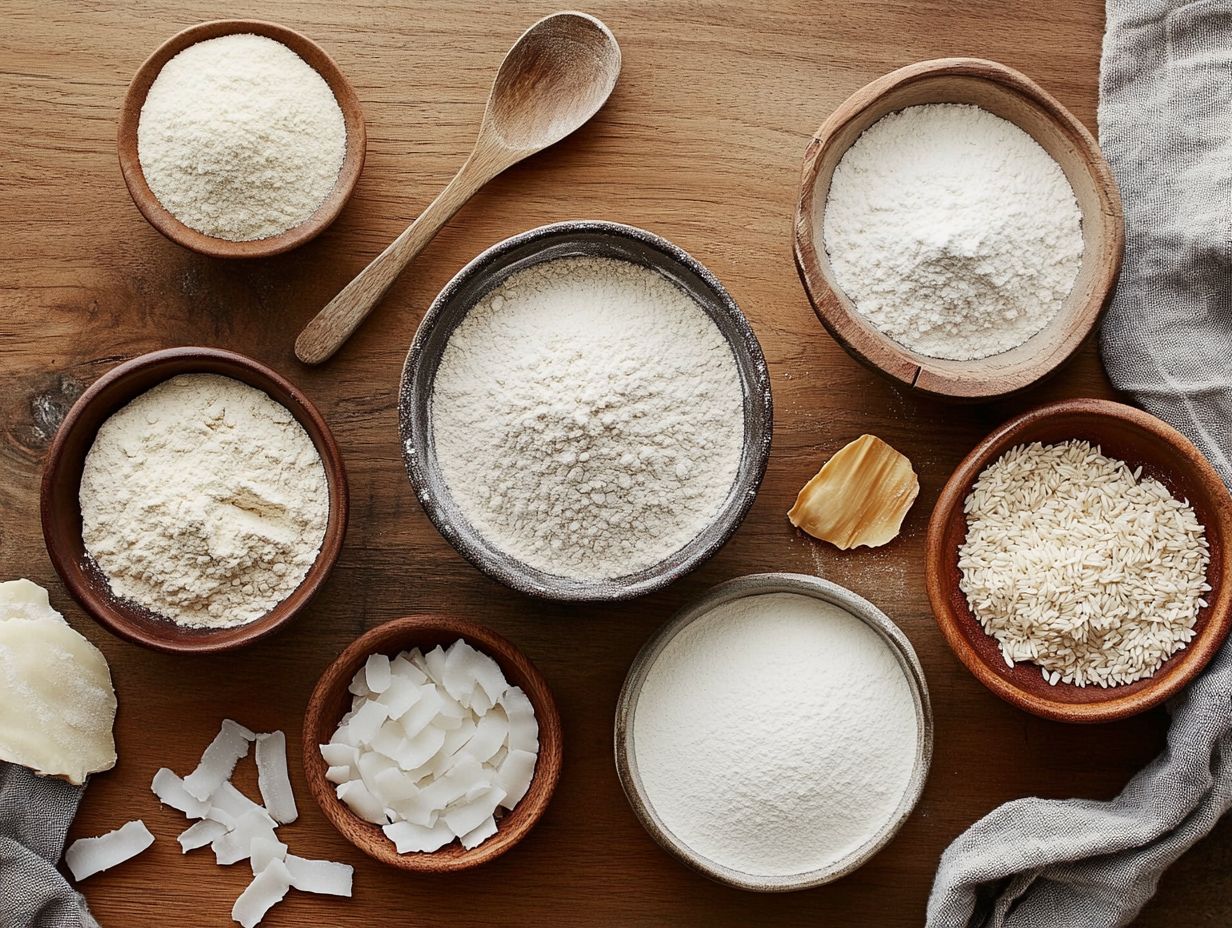
Some common gluten-free baking substitutes include almond flour, coconut flour, tapioca starch, and gluten-free all-purpose flour blends.
Can I use regular wheat flour in place of gluten-free flour?
No, regular wheat flour is not a suitable substitute for gluten-free flours as it contains gluten which gives baked goods their structure and texture. It is important to note that gluten sensitivity and gluten intolerance are common reasons people seek gluten-free alternatives.
Are there any natural gluten-free baking substitutes?
Yes, there are many natural gluten-free baking substitutes such as flaxseed meal, chia seeds, and gluten-free oats. Other alternative flours like almond flour, coconut flour, buckwheat flour, brown rice flour, and sorghum flour can also be used in gluten-free recipes.
Can I use applesauce as a gluten-free baking substitute?
Yes, applesauce can be used as a substitute for eggs in gluten-free baking recipes; however, it will not provide the same structure and texture as eggs. For better binding, you can also consider using xanthan gum, guar gum, or psyllium husk as binding agents in your gluten-free treats.
What is the best gluten-free flour blend for baking?
The best gluten-free flour blend for baking can vary depending on personal preference, but some popular options include Bob’s Red Mill 1-to-1 Gluten-Free Baking Flour, King Arthur Gluten-Free Measure for Measure Flour, and Cup4Cup Multipurpose Gluten-Free Flour. These gluten-free flour blends offer great texture and rise, making them excellent choices for various gluten-free recipes.
Are gluten-free baking substitutes more expensive than regular baking ingredients?
Yes, gluten-free baking substitutes can be more expensive than regular baking ingredients. This is due to the specialized ingredients and processes used to create them.
Many people find that the nutritional benefits and the ability to accommodate dietary restrictions, such as celiac disease (a serious condition where gluten intake can harm the intestines) and veganism, make gluten-free options worthwhile.
Choosing gluten-free ingredients is important for those with dietary restrictions, and it can lead to healthier baking choices.

